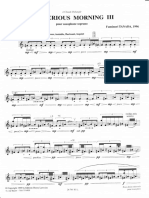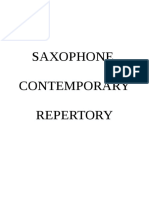Tadj
Tadj
Uploaded by
Li-Fong ChenCopyright:
Available Formats
Tadj
Tadj
Uploaded by
Li-Fong ChenCopyright
Available Formats
Share this document
Did you find this document useful?
Is this content inappropriate?
Copyright:
Available Formats
Tadj
Tadj
Uploaded by
Li-Fong ChenCopyright:
Available Formats
notes and the consecutive popping sound of slap tongue.
The example below shows the continuous slap-tongue section.
Example 4-. Jungle p. 16, line 68. According to Christian Lauba, speaking of the slap tongues found here: Not only do I give them a linguistic content (a sense of diction or phrasing) and form but I use them as expressive elements (Umble 2000, 258). In Chopins Sonata for Piano no. 2 in B flat minor op. 35, the famous Funeral March of its third movement and Finale-Presto of the fourth movement both have a very similar texture and the sense of stormy breath-taking driving. Only after having written this piece, did I notice the similarity between this work and the final movement of Chopins second sonata, said Christian Lauba (Umble 2000, 258). Tdj Tajikistan, officially the Republic of Tajikistan (figure 4-5), is a mountainous country in Central Asia. It borders with Afghanistan to the south, Uzbekistan to the west, Kyrgyzstan to the north, and Peoples Republic of China to the east. Tajikistan also lies adjacent to Pakistan but is separated by the narrow Wakhan Corridor. Most of Tajikistans population belongs to the Tajik ethnic group, who shares culture and history with the Iranian peoples and speak the Persian language (officially referred to as Tajiki in Tajikistan). Once part of the Samanid Empire, Tajikistan became a constituent republic of
the Soviet Union in the twentieth century, known as the Tajik Soviet Socialist Republic (Tajik SSR).
Figure 4-1. Tajikistan and Central Asia. (http://www.reliefweb.int/mapc/cis/reg/cau/caucia.html) In the first book of Neuf tudes, the four etudes have quite clear aims of developing certain techniques and the content of the four compositions stays within a certain degree of simplicity, which by no means implies easy. Tdj is the first etude of the series to which the composer does not assign specific techniques, although it still contains techniques like quarter-tone vibrato, slap tongue, bisbligando, multiphonics and so on. In addition, it is the first etude with an extended length of twelve pages with a total performing time of eight minutes, which is two or even three times the length of any of the first four etudes. The complexity of the content also lifts the etude out of the frame of a study or an etude-like
composition and makes the etude incline more toward a concert piece. The constant switching demands extended techniques, similar to the way Liszts tudes dExcution Transcendante differs from the earlier concert piano etudes; the work does not offer enough repeated patterns or exercises and makes the etude drift further from its original definition and more toward a concert piece. Because of its length, this etude is divided into several sections with different textures, which gives the audience the impression of a form of fast-slow-fast, contrary to Laubas common approach of slow-fast-slow in other etudes such as Balafon, Savane, and Gyn. Tdj is based on three modes: The beginning of Tdj evokes the music which is played in Tdjikistan or Iran where you can find three modes in the same song: our occidental mode, the pentatonic scale (Chinese mode) and the Arabic mode with 1/3 and 1/4 tones.4-3
4-3
Christian Lauba, e-mail to author, February 14, 2009.
Example 4-. Tdj p. 1, line 13. The whole first page is mainly composed of only two notes: the D (tonic) and the A (dominant) in a modal system, which quickly establishes the musical traits from middle eastern and central Asia. The strict definitions and articulation of different attacks are very important through the entire piece. Especially in the first pages, the nuances of the subtle differences within each of the different articulations are so vital. They are not only the languages of the etudes but also the expressions of the phrases. Jean-Marie Londeix has suggested the saxophonist play the first seven lines while circular breathing (Umble 2000, 258). Gyn As notated on the first page of the score, Gyn is the etude based upon the study of attack and resonance. The main foci of techniques in this etude are multiphonics and bisbligando, although some extremely wide interval leaps, along with contrasting articulations and extremely dynamic changes, are also extremely challenging to the performer. Half of the piece is devoted to bisbligando, which is the very subtle timbre trill. The numeration, (or rhythmization by Londeix) of the bisbligando, which
You might also like
- The Klutz Book of Paper Airplanes - DOUG STILLINGERDocument58 pagesThe Klutz Book of Paper Airplanes - DOUG STILLINGERale_mantilla96% (28)
- Crazy Rag Sax SopranoDocument2 pagesCrazy Rag Sax SopranoGil GallardoNo ratings yet
- VillalobosDocument4 pagesVillalobosPedro Corte-RealNo ratings yet
- Tanada Fuminori Mysterious Morning III PDFDocument10 pagesTanada Fuminori Mysterious Morning III PDFFrancesco Rigermo SpinelliNo ratings yet
- Bach for Saxophone: 3 Partitas - BWV 1002, BWV 1004, BWV 1006From EverandBach for Saxophone: 3 Partitas - BWV 1002, BWV 1004, BWV 1006Rating: 5 out of 5 stars5/5 (6)
- 2019阿道夫比赛Document11 pages2019阿道夫比赛HuangNo ratings yet
- Independent Study On Christian LaubaDocument11 pagesIndependent Study On Christian LaubaBig_Saxy100% (3)
- MuczynskiDocument1 pageMuczynskiJack SmithNo ratings yet
- Analysis of Denisov SonataDocument10 pagesAnalysis of Denisov SonataBig_Saxy100% (1)
- 24tet-Quarter Tone Fingering Chart For SaxophoneDocument4 pages24tet-Quarter Tone Fingering Chart For SaxophoneGeorge Christian Vilela PereiraNo ratings yet
- Grande Fantaisie Concertante Op. 47 Oboe and PianoDocument15 pagesGrande Fantaisie Concertante Op. 47 Oboe and PianoPablo LiNo ratings yet
- Quarter Tone Fingering Chart For Saxophone PDFDocument4 pagesQuarter Tone Fingering Chart For Saxophone PDFFedemantraNo ratings yet
- Undergraduate RepertoireDocument3 pagesUndergraduate RepertoireEASsNo ratings yet
- PDF Caprice en Forme de Valse For Solo Saxophone PDFDocument3 pagesPDF Caprice en Forme de Valse For Solo Saxophone PDFgianinny duarteNo ratings yet
- Unaccompanied Saxophone Literature - An Analysis PDFDocument141 pagesUnaccompanied Saxophone Literature - An Analysis PDFBrianKachurNo ratings yet
- AnderGauge SpecsDocument2 pagesAnderGauge SpecsloipvNo ratings yet
- 40K Rogue Trader Weapon Sheet v2.4Document6 pages40K Rogue Trader Weapon Sheet v2.4jdwratcliffe8552No ratings yet
- Electronic Saxophone PieceDocument9 pagesElectronic Saxophone PieceBenjamin ColdNo ratings yet
- Alexander Glazunov ConcertoDocument26 pagesAlexander Glazunov Concertolaura50% (2)
- Dubois Concerto 1Document1 pageDubois Concerto 1Jeremy Hopkins100% (1)
- Sax Prog NotesDocument25 pagesSax Prog NotesJohn100% (1)
- (Sax) Saxophone - Dansiere - Saxophone (Soprano or Alto) - SoloDocument11 pages(Sax) Saxophone - Dansiere - Saxophone (Soprano or Alto) - SoloChemo_per100% (2)
- Kyokhlin Etyudy PartiaDocument25 pagesKyokhlin Etyudy Partiadaryasax100% (1)
- Microtone Presentation ScriptDocument13 pagesMicrotone Presentation ScriptDANANo ratings yet
- PS Asya FateyevaDocument16 pagesPS Asya FateyevaClaus HierlukschNo ratings yet
- BenjaminCold2012 PDFDocument40 pagesBenjaminCold2012 PDFaradjzNo ratings yet
- The Unaccompanied Solos For Saxophone: Scholarly Notes To Accompany A CD Recording ProjectDocument17 pagesThe Unaccompanied Solos For Saxophone: Scholarly Notes To Accompany A CD Recording ProjectDANA100% (1)
- 2003 Plugge1Document19 pages2003 Plugge1gibby09No ratings yet
- Booklet ONYX4065Document18 pagesBooklet ONYX4065chenamberNo ratings yet
- Mikroestructuras para Saxofón Tenor Solo (2002)Document4 pagesMikroestructuras para Saxofón Tenor Solo (2002)joraher100% (3)
- Adolphe SaxDocument2 pagesAdolphe SaxVictor TromboneNo ratings yet
- Neuf Études Balafon Christian Lauba PDFDocument6 pagesNeuf Études Balafon Christian Lauba PDFLorenzo MelsaNo ratings yet
- Competition Repert Orie List SaxophoneDocument20 pagesCompetition Repert Orie List SaxophoneAdrian Paiba100% (3)
- Georges Kastner-SextuorDocument6 pagesGeorges Kastner-SextuorViesturs Celms100% (1)
- Balafon Saxophone LaubaDocument6 pagesBalafon Saxophone LaubarobertNo ratings yet
- Algunas Opciones de Obras para Saxofon Alto y PianoDocument6 pagesAlgunas Opciones de Obras para Saxofon Alto y PianoRaul Cuartero Ballester100% (1)
- Analisis Sonata Decruck (Ingles)Document180 pagesAnalisis Sonata Decruck (Ingles)SaxTena75% (4)
- Tenor PartDocument1 pageTenor PartMarcoNo ratings yet
- The Poetics of A Multiphonic Landscape Reflections On The Project.T Snekkestad 2016Document112 pagesThe Poetics of A Multiphonic Landscape Reflections On The Project.T Snekkestad 2016DaríoNowak100% (2)
- Glazunov History PDFDocument5 pagesGlazunov History PDFJames BarreraNo ratings yet
- Progressive Studies in Double-Tonguing: With by Preston DuncanDocument32 pagesProgressive Studies in Double-Tonguing: With by Preston DuncanLronuCarmonaNo ratings yet
- Schulhoff Erwin Hot Sonate 82763Document6 pagesSchulhoff Erwin Hot Sonate 82763Anonymous IvXgIt8100% (1)
- Sergei Prokofiev Saxophone Lieutenant Kije Film Symphonic SuiteDocument17 pagesSergei Prokofiev Saxophone Lieutenant Kije Film Symphonic SuiteSquawNo ratings yet
- Ballade F.martin (Tenor Part)Document5 pagesBallade F.martin (Tenor Part)Alberto MD100% (1)
- XAS by Iannis Xenakis For Saxophone Quartet PDFDocument11 pagesXAS by Iannis Xenakis For Saxophone Quartet PDFOrlando Rivera100% (2)
- MMDocument18 pagesMMVincenzo Salituri100% (1)
- Competition - Adolphe SaxDocument2 pagesCompetition - Adolphe Saxvulca00% (2)
- Peace-PERFORMING-SCORE-Perusal David Maslanka Cuarteto de SaxosDocument5 pagesPeace-PERFORMING-SCORE-Perusal David Maslanka Cuarteto de SaxosZaRkAkNo ratings yet
- Kabuki Christian LaubaDocument7 pagesKabuki Christian LaubaMyriam Mamèche100% (1)
- Sax Work StockausenDocument153 pagesSax Work StockausenStefano Franceschini0% (1)
- Vocations - Tomasi PDFDocument5 pagesVocations - Tomasi PDFSanti García MarcoNo ratings yet
- Guide To MAslanka Saxophone SonataDocument114 pagesGuide To MAslanka Saxophone Sonatagibby09100% (4)
- Kirk O'Riordan: William Albright's Sonata For Alto Saxophone - A Study in Stylistic ContrastDocument30 pagesKirk O'Riordan: William Albright's Sonata For Alto Saxophone - A Study in Stylistic ContrasteightronNo ratings yet
- Congreso Zagreb ProgramaDocument56 pagesCongreso Zagreb ProgramaAlexandre Gallego MedalNo ratings yet
- Altissimo Fingerings For Baritone SaxophoneDocument1 pageAltissimo Fingerings For Baritone SaxophoneBruno SantosNo ratings yet
- Russel PianoDocument41 pagesRussel PianoJoel ZagarNo ratings yet
- Repertoire List: Premieres/Works Written and Arranged For Noah GetzDocument4 pagesRepertoire List: Premieres/Works Written and Arranged For Noah GetzrishNo ratings yet
- Saxophone Quartet "Little" Fugue in G minor (set of parts): intermediate levelFrom EverandSaxophone Quartet "Little" Fugue in G minor (set of parts): intermediate levelRating: 5 out of 5 stars5/5 (1)
- Christmas for Four - medley for Saxophone QuartetFrom EverandChristmas for Four - medley for Saxophone QuartetNo ratings yet
- THE TEACHING OF SAXOPHONE OVER TIME: From Adolphe Sax to the present dayFrom EverandTHE TEACHING OF SAXOPHONE OVER TIME: From Adolphe Sax to the present dayNo ratings yet
- 2015 Corvette BrochureDocument16 pages2015 Corvette BrochureAlberto Fernandez0% (1)
- Halloween in France: Daniel Andrés Navarro TovarDocument13 pagesHalloween in France: Daniel Andrés Navarro TovarDANIEL NAVARRONo ratings yet
- Presentation Memorial Sergio Castelletti, Europe Cup U12, Coppa Italia Open U10, Open Italy Cup U10, Exhibition CupDocument10 pagesPresentation Memorial Sergio Castelletti, Europe Cup U12, Coppa Italia Open U10, Open Italy Cup U10, Exhibition CupMemorial Sergio CastellettiNo ratings yet
- ChordDocument14 pagesChordYadi RidayNo ratings yet
- FoodDocument3 pagesFoodani7kNo ratings yet
- Mr.&ms. Intrams '09 ScriptDocument3 pagesMr.&ms. Intrams '09 ScriptJanibie John Pascua82% (11)
- TLSL 3428Document232 pagesTLSL 3428viniciusemanuelNo ratings yet
- I Like The Flowers: Children's SongDocument7 pagesI Like The Flowers: Children's SongAmber NorderNo ratings yet
- Gajukuntapalli Road Data 2023-24Document50 pagesGajukuntapalli Road Data 2023-24VannurSwamyNo ratings yet
- GSMA Intelligence - The B2B Opportunity in The 5G EraDocument28 pagesGSMA Intelligence - The B2B Opportunity in The 5G EraAngel CuevasNo ratings yet
- IMT 546 WAN TechnologiesDocument34 pagesIMT 546 WAN TechnologiesminhtuanqniNo ratings yet
- White.: NetflixDocument196 pagesWhite.: NetflixFandom ArtNo ratings yet
- IndexDocument1 pageIndexEric GrissomNo ratings yet
- Malaysian Music - Nobat and CaklempongDocument3 pagesMalaysian Music - Nobat and CaklempongAidan TeohNo ratings yet
- Study of Indian English PoetsDocument11 pagesStudy of Indian English PoetsPranjalGoelNo ratings yet
- ĐỀ ĐỌC VIẾT NÓI LỚP 3 KÌ 2Document5 pagesĐỀ ĐỌC VIẾT NÓI LỚP 3 KÌ 2Hoàng HườngNo ratings yet
- User's Manual: Zebra P110 I Card PrinterDocument58 pagesUser's Manual: Zebra P110 I Card PrinterAnonymous 1hBXEhNo ratings yet
- Experiences: 2. Outdoor ActivitiesDocument31 pagesExperiences: 2. Outdoor ActivitiesLeandro AlvarezNo ratings yet
- Price List Cheetah 2021 35Document1 pagePrice List Cheetah 2021 35Burhanuddin NashrulNo ratings yet
- The Reeves Tale ScriptDocument2 pagesThe Reeves Tale Scriptwihebe hailegebrielNo ratings yet
- Putting SpeedsDocument452 pagesPutting SpeedsNaqi AbbasNo ratings yet
- Dead Stars by Paz Marques-Benitez I. CharactersDocument4 pagesDead Stars by Paz Marques-Benitez I. CharactersDea EspañolaNo ratings yet
- Satir g96 Thermal Imaging Camera ManualDocument1 pageSatir g96 Thermal Imaging Camera ManualRomualdy WidiyantoNo ratings yet
- First Editing Feasibility and Acceptability of Suman SushiDocument69 pagesFirst Editing Feasibility and Acceptability of Suman SushiRica Mae AleaNo ratings yet
- Gurgle Click : Resistances - Necrotic, RadiantDocument4 pagesGurgle Click : Resistances - Necrotic, RadiantMichael OhmNo ratings yet
- Nutrition Quiz - Answer KeyDocument29 pagesNutrition Quiz - Answer Keynoctis280% (3)
- UE12Document4 pagesUE12mug85No ratings yet

























































































